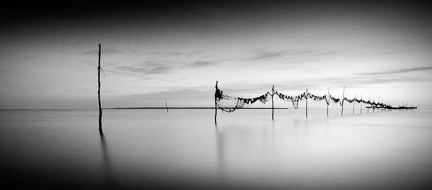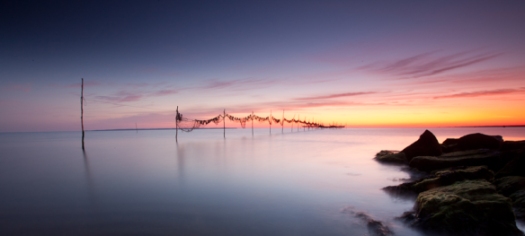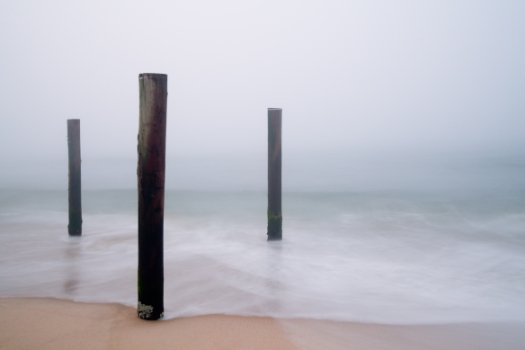I’m continuing to play with black and white conversions of photos from my archive. The above photo is the latest image that I’ve played with and is one that was originally posted here and is also below. Check out the original and the new version – I’d be interested in your comments.
Photography Now
I was quite excited to find out that the image above ‘Three Beach Pilings’ was selected to be included in the South Shore Art Center exhibition ‘Photography Now‘ curated by Karin Rosenthal. The exhibition opening is April 12 from 6pm – 8pm. Please do stop by and say hello if you’re in the area.
Taking a Mulligan
Everyone deserves the opportunity to have another go, to reinterpret and reimagine their work. The more that I understand lightroom and photoshop the more possibilities there seem to be. In an interview with Michael Kenna I recently read he said that one of photography’s greatest strengths is that it is (or at least was) tied to reality. That tie is clearly broken for those that wish it to be. While I’ve yet to push reality hard, I have started to play a little. The image at the top of the page is a reworking of the image that I posted a few weeks ago based on the feedback that i received here and to fix a few things that bugged me which I didn’t know how to fix at the time. So a mulligan, a do over, let me know your thoughts.
Friday Inspiration: Wolfgang Bloch
I’m always on the look out for how artists represent the ocean and in that search recently came across Wolfgang Bloch‘s work on the web and in his book ‘Wolfgang Bloch: The Colors of Coincidence‘. Wolfgang is a California based painter who has an interesting approach – he uses juxtaposition of materials as the substrate for his paintings which are often two solid fields of color with a breaking wave at the meeting of those fields. His work is subtle and quiet and looking at it I can easily imagine being along on a stormy beach looking out to sea. Check out more of his work here: www.wolfgangbloch.com and listen to Wolfgang talking about his work below.
Looking at Photographs: A Way to Improve Your Photography
Getting basic techniques down and being able to replicate photographs that others have made is all well and good. But how do you advance beyond that to make photographs that are unique, that express your unique vision.
Many people use the struggles and creative processes of writers to help guide the photography path. Skeptical? Take a look at Stephen King’s book ‘On Writing‘ and change his mention of writing for photography and you’ll see what I mean.
My development as a photographer has paralleled the way I learned to play the guitar. I spent many hours learning how to play songs and even more time how to play blues riffs. At first this was following along with instructional books and CDs, as an aside David Hamburger and Dave Rubin produced some phenomenal instructional books and CDs, and then later working out riffs for myself from the CDs that I had. This let me build up a series of phrases that I could be dropped into either my own songs or the songs of others, in many ways like learning elements of photographic technique that will later be pieced together to make an image.
For both writing and learning to play the guitar there comes a point where progression comes from studying the work of others. Either reading more in the case of writing or listening more when it comes to learning an instrument. The same is true for photography. We’re surrounded by images but I suspect that few of us take the time to really look at them, to really see. When was the last time you went to an exhibition of photography or painting? When was the last time that you pulled one of your coffee table photography books down and spent 10 minutes looking at a single image?
If you’re like me, more engineer than artist, perhaps part of the reason is that you don’t have the language to describe what your seeing and you could argue if we could use words we’d be writers. The very act however of simply describing the image in front of you is enormously useful first step in becoming comfortable with describing photographs and identifying elements within them that you could use in your own photography. The more time you spend looking at other photographs the more photographs you’ll see when you have your camera in hand.
So how to start? Start with a very basic description: What is it a photograph of? Color or black & white? Shape of the frame? Where was it taken? When was it taken? How was it taken? Then go beyond the basics: Why was it taken? How does it make you feel?
I’d be interested in your feedback and comments if you run through this exercise with the image above.
Friday Inspiration: Joe Cornish
Joe Cornish is one of those photographers whose work I continue to return to. Much of what he does is shot in the part of England, Yorkshire, that I consider home and his ability to articulate what he’s thinking as he frames a particular shot is instructive. I’m also lusting after the Linhof Techno camera and the Phase One back but that’s a different topic entirely. Find out more about Joe Cornish here and enjoy the videos below.
Friday Inspiration: Thomas Joshua Cooper
I’m intrigued by Thomas Joshua Cooper’s work, made with a 100 year old field camera, particularly that which documents the atlantic basin. In this project Cooper is charting the extremities of the land and islands that surround the Atlantic Ocean. As I understand it each photograph begins as a location that he finds on a map, this is then further researched before the trip which because of the typically remote location often involves difficult journeys by air, sea and land. Once on site Cooper makes only one photograph, the product of a lot of gazing and waiting.
Some of this work is captured in his book ‘True‘ that I’m now waiting for to arrive.
Check out the video of Thomas Joshua Cooper below:
My 5 Keys to A Great Workshop Experience
My recent experience at Art Wolfe’s Olympic Peninsula Workshop, while not bad per se, led me to reflect on what my ideal workshop would look like. My goals for any workshop are to have fun, make friends, learn something and if I get some photographs that I like so much the better. With that in mind here’s what i came up with.
I prefer relatively small groups
The reason for this is two fold. I want to get to know the people that I’m with for the duration of the workshop. Some of these folks often know more about the technical aspects of photography, or the software than the instructor does. Handy to know these people.
I want to get to know the instructor and allow the instructor to know me.
I feel like this can only be a good thing when it comes to learning and overcoming challenges that I’m dealing with.
Daily critiques of new work
While it can be painful, I find that daily critique of the images that the group has created is a powerful tool to improve the standard of the work that the whole group does. Which leads to the next point.
I want to feel safe enough to step outside of my comfort zoneOne of the things that workshops afford us is the opportunity to try things and quite likely fail spectacularly. I’m not likely to do this or at least share the results of my experiments if I don’t feel safe.
I don’t want to be rushed
Workshops are a funny vehicle for learning. Often you are sprinted from one location to the next without an opportunity to return and put what you’ve learned into practice. I completely understand the ‘photo tour’ aspect of many workshops and this is great if you intend on returning to select locations on your own to fully work through the photo possibilities that it offers. Otherwise I prefer at least similar locations that would allow me to refine my thinking about how to approach particular subjects.
What would help make the ideal workshop experience for you? Leave your suggestions in the comments section.
Friday Inspiration: Michael Eudenbach
I think one of the challenges that we all have as photographers is showing the everyday in new and interesting ways. Michael Eudenbach is one photographer who seems to make doing this easy, making photographs that I always enjoy looking at. His photograph of the bow of Endeavour, shown above is a particular favorite. Michael has a talent for finding a unique way of representing the scene in front of him, resulting in photographs that make you feel as though you’re part of the action. You can find more of Michael’s photographs here. Check out the video below that shows one way that Michael uses to find unique viewpoints. For personal feedback on your images you can find Michael on PhotoSynesi
Friday Inspiration: Mickey Smith
One of the great pleasures in my life is being around the coast, being on and in the water. In that regard surf photographer Mickey Smith lives an enviable life. Click here to read an interview with Mickey published in Huck Magazine.
Check out Mickey’s short film ‘Dark Side of the Lens’ below.
DARK SIDE OF THE LENS from Astray Films on Vimeo.









